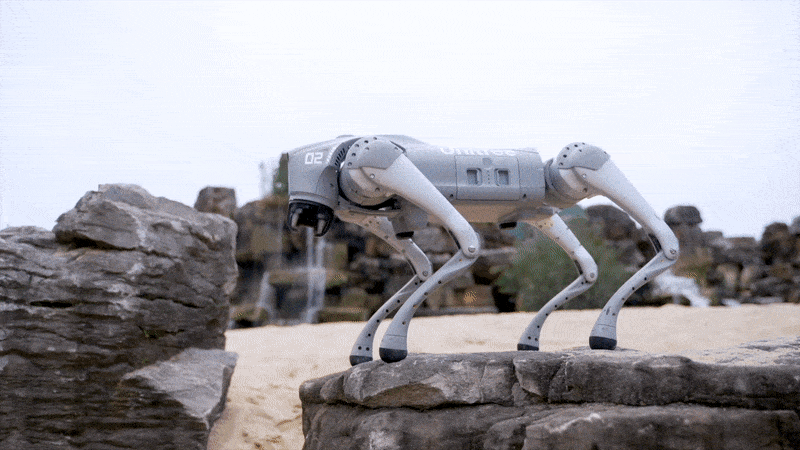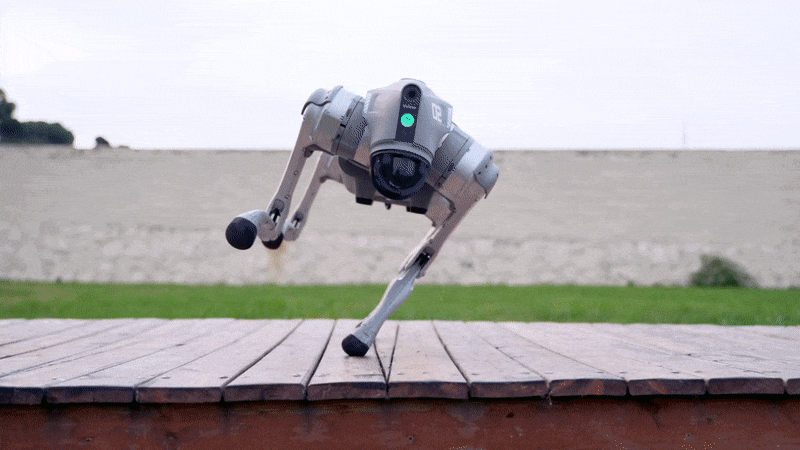It’s been just two years since Hangzhou, China–based Unitree introduced the Go1, a US $2,700 quadruped robot. And since then, the Go1 has had a huge influence over the small quadruped-research market, due to its unique combination of performance, accessibility, and being (as legged robots go) supercheap.
Unitree has just announced the Go2, a new version that manages to both be significantly better and super-duper-cheap—it’s faster and more agile and now even includes a lidar, but somehow costs just $1,600.
Okay, yes, some of the word choice in that video is slightly odd. But who cares, because that’s some very impressive, dynamic mobility at a shockingly low cost. The $1,600 base model, the Go2 Air, includes a chin-mounted 360- by 90-degree hemispherical lidar, which has a minimum sensing range of 0.05 meters for intelligent terrain navigation and obstacle avoidance. The Go2 can move at a brisk 2.5 meters per second with a 7-kilogram payload, and operates for up to 2 hours with a 8000 milliamp-hour (mAh) battery. There’s even a graphical programming interface, if you have no idea what you’re doing but just want to mess around a little bit.
Like its predecessor, the Go2 is available in several different models. For $2,800, you get the Go2 Pro, with an additional kilo of payload capacity, an extra meter per second of speed, onboard compute, and 4G connectivity. It also comes with side-following, which is what will let the robot go for a jog alongside you. And if you need even more, the Go2 Edu (which you’ll have to contact Unitree about directly) boasts a peak speed of a blistering 5 m/s, has force sensors on its feet, and will run for up to 4 hours with a 15,000-mAh battery.

“Go2 was a huge project with many difficulties we had to overcome,” Unitree founder and CEO Xingxing Wang told IEEE Spectrum. “We have researched and developed almost every mechanical part and circuit board. Through continuously improving the design, we tried hard to improve its performance and quality as well as reduce costs, which required a lot of work and effort.”
We also asked Wang what has impressed him the most about how other people have used his robots. “We are very happy that many global institutions and companies use our quadruped robot in meaningful and innovative development,” he says. He points to a couple of his favorite examples, including CSIC using a Go1 as a robot guide dog that he hopes will have significant benefits for the visually impaired, and a recent paper in Science Robotics that uses a brain-inspired multimodal hybrid-neural network running on a Go1 for place recognition.
Lastly, we wanted to know whether all of this new footage of Go2 balancing on two legs means that Unitree might be taking an interest in bipeds sometime soon. “I think it’s cool that a quadruped robot can realize bipedal locomotion,” says Wang. “We may try to make a bipedal robot on the basis of a quadruped robot.” Yeah, sign us up for that.
Evan Ackerman is a senior editor at IEEE Spectrum. Since 2007, he has written over 6,000 articles on robotics and technology. He has a degree in Martian geology and is excellent at playing bagpipes.



